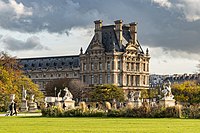ファイル:Paolo Veronese - The Marriage at Cana (detail) - WGA24857.jpg

元のファイル (1,036 × 1,154 ピクセル、ファイルサイズ: 184キロバイト、MIME タイプ: image/jpeg)
ウィキメディア・コモンズのファイルページにある説明を、以下に表示します。 |
| パオロ・ヴェロネーゼ: カナの婚礼 | |||||||||||||||||||||||||
|---|---|---|---|---|---|---|---|---|---|---|---|---|---|---|---|---|---|---|---|---|---|---|---|---|---|
| 作者 |
artist QS:P170,Q9440 | ||||||||||||||||||||||||
| タイトル | The Marriage at Cana (detail) | ||||||||||||||||||||||||
| 分野 | 絵画作品 | ||||||||||||||||||||||||
| ジャンル | 宗教美術 | ||||||||||||||||||||||||
| 解説 | |||||||||||||||||||||||||
| 描画された人物 | |||||||||||||||||||||||||
| 日付 | 1563年 date QS:P571,+1563-00-00T00:00:00Z/9 | ||||||||||||||||||||||||
| 技法 | キャンバス、油絵 medium QS:P186,Q296955;P186,Q12321255,P518,Q861259 | ||||||||||||||||||||||||
| 寸法 | 高さ: 677 cm dimensions QS:P2048,+677U174728 dimensions QS:P2049,+994U174728 | ||||||||||||||||||||||||
| 所蔵者 |
institution QS:P195,Q19675 | ||||||||||||||||||||||||
| 所蔵 | |||||||||||||||||||||||||
| 台帳番号 | INV 142 and MR 384 (ルーヴル美術館絵画部門) | ||||||||||||||||||||||||
| 製作された場所 | ヴェネツィア共和国 | ||||||||||||||||||||||||
| 作品の来歴 |
| ||||||||||||||||||||||||
| 参考文献 |
| ||||||||||||||||||||||||
| 典拠管理 | |||||||||||||||||||||||||
| 情報源/撮影者 | ウェブ・ギャラリー・オヴ・アート: reference_wga QS:P973,"http://www.wga.hu/html/v/veronese/06/2cana2.html" | ||||||||||||||||||||||||
| 許可 (ファイルの再利用) |
| ||||||||||||||||||||||||
| その他のバージョン |
| ||||||||||||||||||||||||
キャプション
ファイルの履歴
過去の版のファイルを表示するには、その版の日時をクリックしてください。
| 日付と時刻 | サムネイル | 寸法 | 利用者 | コメント | |
|---|---|---|---|---|---|
| 現在の版 | 2011年6月4日 (土) 11:14 |  | 1,036 × 1,154 (184キロバイト) | JarektUploadBot | {{Artwork |artist = {{Creator:Paolo Veronese}} |title = The Marriage at Cana ({{detail}}) |description = |date = 1563 |medium = {{Oil on canvas}} |dimensions |
ファイルの使用状況
以下のページがこのファイルを使用しています:
メタデータ
このファイルには、追加情報があります (おそらく、作成やデジタル化する際に使用したデジタルカメラやスキャナーが追加したものです)。
このファイルが元の状態から変更されている場合、修正されたファイルを完全に反映していない項目がある場合があります。
| JPEGファイルのコメント | VERONESE, Paolo (b. 1528, Verona, d. 1588, Venezia) The Marriage at Cana (detail) 1563 Oil on canvas Musée du Louvre, Paris Covering a total area of about 67 square meters, the painting for the dining room of the Benedictine monastery of San Giorgio Maggiore in Venice depicts the biblical scene of the wedding at Cana (St. John 2, 1-11). When the wine ran out during the meal, Christ changed water into wine at the request of his mother Mary. Veronese moves the scene to a brightly lit terrace in front of imaginary Venetian palace facades. In the second half of the 16th century, the increased interest in rich subject-matter among painters and clients in Venice and the Veneto led to the simple core event (initially just the miracle of the wine) being gradually overlaid with lavish settings of more and more markedly realistic depictions of wedding gatherings. Yet in Veronese's painting, the compositional parallels with depictions of the Last Supper nonetheless manage to bring out the analogy between the transformation of the water into wine and sacramental wine into the blood of Christ. The contract of June 6, 1562 specified both the exact size and the appropriate number of figures for the subject. As a precaution, Veronese was instructed to use only the best raw materials for his paints and not to omit the use of the finest ultramarine. As ultramarine, made from ground lapis lazuli, was highly expensive, the intention of this admonition was to circumvent the current practice whereby painters often short-changed their clients by using azure blue made from copper ore. The agreed fee for the painting was 324 ducats. While he was working on the picture on the island of San Giorgio, the artist had free board, and was promised a barrel of wine on completion of the picture. The monumental painting was finished 17 months later. Veronese probably had Benedetto Caliari with him as his assistant. Once famed as one of the principal sights of Venice and admired for centuries both north and south of the Alps as a masterpiece of Venetian art, the work remained influential into the 18th century. Looted by Napoleon, in the 19th century it was studied, copied and taken as a model by generations of French, German and English artists visiting the Louvre. Among the interesting discoveries made during the restoration of the Marriage at Cana between 1989 and 1992 is the head of a Benedictine painted on paper and stuck post hoc on the canvas. This is possibly Andrea Pampuro, known as Andrea da Asolo, who became abbot of San Giorgio Maggiore in succession to Girolamo Scrochetto in 1564. The most expensive technical equipment has not been able to clarify whether the head - presumably carried out by an assistant of Veronese - replaced an already existing figure.
Author: VERONESE, Paolo Title: The Marriage at Cana (detail) Time-line: 1551-1600 School: Italian Form: painting Type: religious |
|---|


 French
French Deutsch
Deutsch



